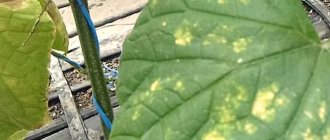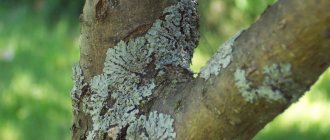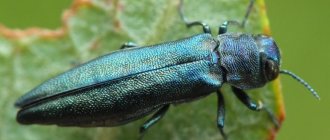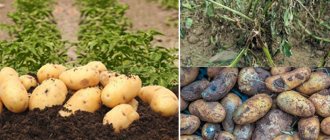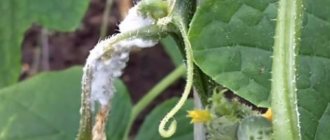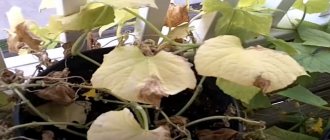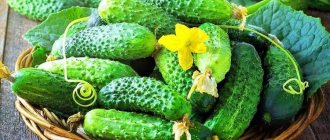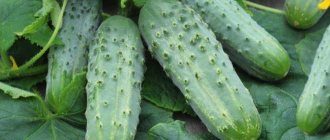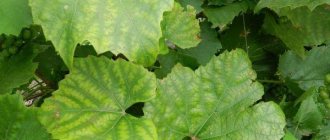Causes of disease development in cucumbers
Violation of the rules of crop care and violation of agricultural practices can serve as fertile ground for the development of various diseases. These factors include:
- Insufficient or excessive watering. Excessively moist soils provoke the development of rot, while dry soils serve as a habitat for many pathogenic bacteria.
- Deficiency or excess of nutrients, macro- and microelements introduced during feeding. Both conditions are extremely harmful to the plant, reducing its immunity and susceptibility to diseases and pests.
- Poor weeding (or lack thereof). Weeds attract the attention of microbial-carrying insect pests and serve as a breeding ground for them.
- Lack or insufficient loosening. The hard crust that forms on the soil surface prevents the normal penetration of air, moisture and nutrients to the roots.
- Excessive planting density, which contributes to disruption of air exchange and the creation of conditions optimal for the development of various pathologies.
- Insufficient disinfection of the soil, equipment used, and cultivation facilities (or lack thereof).
- Poor quality treatment (or lack thereof) of pruning areas (pinching, pinching), which contributes to the spread of infections.
Such moments include the difference between night and day temperatures, as well as sudden cold snaps. These factors are not always predictable, but have an extremely adverse effect on the development of diseases, especially in combination with rain.
What can cause cucumbers?
A decent harvest of cucumbers is the dream of any gardener.
Cucumbers are often affected by various diseases. Some are not infectious in nature - these are, for example, a deficiency of nutrients, stress from the negative influence of the environment. Others, caused by viruses, bacteria, fungi, can be classified as infections. Fungal diseases of cucumbers are the most common; the composition of this group of diseases is very extensive. It includes:
- Alternaria blight;
- anthracnose;
- ascochyta;
- white rot (sclerotinia);
- verticillium and fusarium wilt;
- cladosporiosis;
- powdery mildew;
- peronosporosis;
- rhizoctoniasis.
There are also other cucumber ailments caused by parasitic fungi.
Bacterial diseases include: angular leaf spot, bacterial wilt, bacterial fruit rot, blackleg. Examples of viral lesions are various cucumber mosaics.
The descriptions given below will make it possible to recognize diseases of cucumbers in time, and photos of leaves and other parts of plants will help to visually represent dangerous ailments.
Prevention of cucumber diseases
Compliance with all of the above requirements is the most important preventive measures to prevent diseases. Additionally, preventive measures should include:
- Timely removal of all lifeless areas of the plant and disinfection of the cuts.
- Compliance with crop rotation rules from the point of view of predecessors:
- favorable - peas, cabbage, peppers, tomatoes, radishes, beans;
- unfavorable - watermelons, zucchini, cucumbers, pumpkin.
- Planting cucumbers in one area no more than every 4 years.
- The use of green manure plants (mustard, oats, rye, etc.) after harvesting with their further digging and embedding of seedlings into the soil.
- Use of high-quality seeds and seeding material.
- Destruction of aphids and insects that carry them.
- Remote planting of cucumbers from:
- watermelons and melons (common pollinating insects);
- garden flowers, the sweet juice of which serves as a breeding ground for aphids.
Regardless of the cause of the lesion, all diseased crops must be removed and destroyed, followed by appropriate treatment of the area. In case of mild infection, the affected areas are trimmed and the cut areas are treated with disinfectant solutions.
LiveInternetLiveInternet
There are many signs of cucumber diseases, some of which can confuse even an experienced gardener. But if you carefully examine the bush, it will be easier to figure out how to preserve the harvest. All diseases of cucumbers can be divided into several groups: fungal, bacterial and viral. Often gardeners do not even realize that their plant is sick, because it is not easy to calculate and determine the disease. Let's carefully look at the leaves, stems and fruits of the cucumber and try together to determine what is wrong with the plant.
FUNGAL DISEASES OF CUCUMBERS Fungal diseases are found in cucumber beds more often than others. Hot weather, high humidity, the presence of pests and errors in agricultural technology almost always lead to poor health in cucumbers. In the worst case, up to 50% of the crop can suffer from the diseases described below! Let's find out what fungal disease has affected the bushes and how to treat the cucumber leaves for their recovery. When using chemicals, remember that cucumbers can only be eaten 3-4 weeks after the last treatment. SMALL CONVEXED BROWN SPOTS ON CUCUMBER LEAVES The leaves along the edges and in the middle are covered with small, slightly convex spots (up to 2 cm in length) of brown color. After a while, the spots merge, the leaf dries and dies. There are no spots on the fruits or stems.
Diagnosis: Alternaria blight (dry spotting) of cucumbers. Alternaria usually affects greenhouse cucumbers, which grow at the entrance to the greenhouse and often experience temperature changes. First, scattered spots appear on the lower leaves, then they merge and cover almost half of the leaf blade. The process of photosynthesis is disrupted, the formation of ovaries and fruits slows down. The growth of the fungus is promoted by high humidity and temperatures within 30°C. The disease is quickly transmitted to other plants. Plants in film greenhouses are affected by Alternaria more often than in glass greenhouses. The main carrier of the disease is aphids. Control measures. At the onset of the disease, spraying with copper sulfate (20 g per 10 liters of water), as well as fungicides (Bravo, Abiga-Pik, Quadris, etc.) are effective. Apply treatments every 10-14 days until the leaves look healthy. If you want to use biological drugs, pay attention to Trichodermin, which is safe for people and animals. It can also be used in the spring for preventive tillage of the soil. WHITE POINT ON CUCUMBER LEAVES The lower and upper sides of the leaves are covered with a white coating. Round spots are located throughout the leaf blade, then merge and darken.
Diagnosis: powdery mildew of cucumbers. Powdery mildew is the most common disease of garden plants. It can be found on cucumbers in greenhouses and in open ground. The white coating is easy to notice: the plant seems to be sprinkled with flour. If you do not take action, the leaf will begin to deform, then bend outward and die. The disease spreads throughout the cane, covering the stems and petioles of the fruit. The greens themselves are bitter. As a result, the plant cannot set new fruits, and the yield quickly decreases. After a while, the bush dies. The main cause of damage is an excess of nitrogen fertilizing and improper watering. Control measures. After identifying the first foci of powdery mildew on cucumbers, spray the bushes with a soda solution (100 g per 10 l). You can add a little laundry soap to it so that the solution sticks better to the leaves. Carry out the treatment 6 times every 7 days until the plaque disappears. Among the chemical preparations, Novosil, Falcon, Topaz, Baktofit, Karatan, Topsin-M have proven themselves well. RED SPOTS ON LEAVES, STEMES AND FRUITS OF CUCUMBERS Leaves, stems and fruits are covered with spots (up to 4 cm) of red color. Then holes form in their place. Zelentsy become covered with brown ulcers and stop growing.
Diagnosis: anthracnose (verdienne) of cucumbers. The disease affects cucumbers at all stages of development. Already on the root collar of the seedlings you can notice small brown spots. But basically, anthracnose is diagnosed by spots on the leaves of adult plants. The proliferation of the fungus is promoted by high humidity (sometimes it is enough to reduce it to save the plants), as well as by uncleaned plant debris. The disease quickly spreads from one bush to another. Control measures. To treat anthracnose, treat the beds with a 1% solution of Bordeaux mixture or a 0.4% solution of copper oxychloride. After 2 weeks, repeat spraying. You can also use Ridomil Gold, Poliram, Kuproksat, Oksikhom and other fungicides. When using any chemicals, wear gloves and a respirator. Always read the instructions for use. This will protect not only your health, but also the environmental situation on the site. Pale spots along the edges of cucumber leaves and brown spots on stems. The edges of the leaves become lighter and become covered with pale spots, which then spread to the entire leaf blade. Brown spots are visible on the stems. The peel of the fruit darkens, black dots are visible on it.
Diagnosis: ascochyta blight (black mycospherella stem rot) of cucumbers. The disease manifests itself mainly at the beginning of the growing season, when the stems become covered with whitish spots. But the damage becomes noticeable during the fruiting period. The infection does not affect the vascular system of the plant, so the bush continues to bear fruit. But the fruits are not suitable for food; they are ulcerated on the outside, and the pulp inside is decomposing. If left untreated, the plant dies completely. Ascochyta blight most often affects greenhouse cucumbers. Control measures. Every 10 days, spray the plants with a 1% solution of Bordeaux mixture. Repeat the procedure 3-4 times. You can also add urea (10 g per 10 liters of water) to the solution to nourish the bushes. Dust the stems with a mixture of copper sulfate and chalk (1:1). Remove lower affected leaves to control the spread of the fungus. SMALL DARK BROWN SPOTS ON CUCUMBER LEAVES, GRAY POINT ON THE STEM AND ULTRAS ON THE FRUITS The leaves are covered with small dark brown spots, which after time acquire an olive-gray tint. In places where tissues die, holes with torn edges appear. The fruits are twisted and have visible ulcers. The stems are covered with a gray coating and die off along with the leaves.
Diagnosis: cladosporiosis (olive spot) of cucumbers. In summer, cladosporiosis mainly affects young fruits, which are no longer suitable for food. Stems and leaves get sick less often. The development of the fungus is affected by air humidity; as soon as it exceeds the norm of 80%, the spores become active and multiply en masse. In a short time, the entire greenhouse or open ground bed can be affected. Control measures. For treatment, you can use a 1% solution of Bordeaux mixture. A 0.3-0.4% solution of copper oxychloride will also help stop the spread of the pathogen. Spray every 10-12 days at least 3-4 times per season. For prevention, use the biological fungicide Pseudobacterin-2. WHITE FLUFFY PATURANCE ON CUCUMBER STIMLES AND FRUITS A fluffy white coating appears on the stems and fruits, and the tissues soften. The plant gradually withers and dies.
Diagnosis: white rot of cucumbers. At risk are greenhouse cucumbers and plants planted near lettuce and parsley. The mycelium of the fungus multiplies very quickly and can damage all cucumber bushes. For its development, it is enough to violate just a few rules of agricultural technology, for example, to thicken the plantings or not remove dead parts of plants in time. It is easy to infect plants when working with dirty tools. Affected greens are not suitable for food. Greens become infected with rot most quickly if they come into contact with diseased stems. Control measures. First of all, coat the plant stems with fungicides Sumilex or Rovral. To improve the effect, add chalk (1:1) to the preparations. To strengthen the immune system and fight white rot on cucumbers, spray the bushes with a mixture of 2 g of copper sulfate, 1 g of zinc sulfate and 10 g of urea per bucket of water. CUCUMBER LEAVES DIE AND THE STEMES DRY The stems dry out and become thinner, the leaves die off. The roots are covered with brown spots.
Diagnosis: root rot of cucumbers. This disease is not so easy to notice. During hot hours, the lower leaves of plants turn yellow and fade slightly, as if from a lack of moisture. Additional watering only aggravates the matter; the pathogenic fungus actively multiplies, and the above-ground part of the plant becomes weaker. The roots rot, and the greens grow crooked, underdeveloped and tasteless. The appearance of a fungus at the beginning of the growing season can completely deprive you of your cucumber harvest! Wilting can also occur with verticillium and fusarium blight on cucumber. Control measures. It is very difficult to fight root rot; it is easier to prevent it. It is important to water the plants only with warm water, strictly according to the schedule, and dust the lower part of the bushes with peat or chalk. If root rot does appear, use the drug Previkur for treatment, which will suppress the activity of the fungus. OF CUCUMBERS WITHER During the day, the tops of the bushes wither, and at night they come to life again. After a while, the leaves turn yellow and the plant dries out.
Diagnosis: Fusarium wilt of cucumbers. In a short time the bush dies completely. The development of the disease accelerates at low temperatures and waterlogged soil, so cucumbers in open ground are at risk. Wilting can be sluggish, when the bushes bear fruit but quickly age. The main cause of infection is contaminated seeds. There is also Verticillium wilt, which is favored by high greenhouse temperatures. Control measures. For treatment, use broad-spectrum fungicides, for example, Previkur, Consento, etc. Water the plants with the solution 1-2 times at the interval specified by the manufacturer. Dig up and burn dead plants, disinfect the ground with Trichodermin. LIGHT YELLOW SPOTS ON THE UPPER SIDE OF CUCUMBER LEAVES AND A GRAY-VIOLET POINT ON THE BOTTOM The leaves become covered with light yellow spots, darken and die. A gray-violet coating appears on their lower part.
Diagnosis: downy mildew (downy mildew) of cucumbers. Downy mildew becomes more active in cold and rainy weather. The spread of the fungus is facilitated by watering with cold water and temperature changes, and in greenhouses by the formation of condensation on the walls. Light spots on the leaf blades turn brown over time, the process of photosynthesis is disrupted, but the leaves do not fall off. Weak plants die 2 weeks after infection. Control measures. When the first signs appear, immediately begin treatment for peronosporosis. Spray the leaves with Fitosporin-M, Gamair, Ridomil Gold, Consento. It is important to carry out the treatment as soon as possible, otherwise the bush will no longer be saved. Do not overuse fungicide spraying. In excessive quantities, they harm plants and soil, dry out leaves, slow down shoot growth and reduce plant immunity. BROWN SPOTS ON CUCUMBER FRUITS AND LEAVES The fruits are covered with brown spots, sometimes black fungal mycelium is visible on them. The petioles are ulcerated. The leaves have brown spots with a whitish coating.
Diagnosis: cucumber rhizoctonia. The disease causes enormous damage to plantings at the beginning of the growing season. The fungus affects cucumbers both in the greenhouse and in the open ground. Moreover, almost all parts of the plant become infected, except for the flowers. The fungus itself lives in the soil, sometimes quite deep (up to 25 cm). Its development is not affected by either humidity or temperature. But dense plantings and improper watering allow rhizoctonia to show all its harmfulness. Control measures. The drugs Ridomil Gold and Trichodermin are effective. For prevention, use Quadris and Strobi, and soak the seeds in Baktofit or Pseudobacterin-2 before sowing. Most often, fruits that touch the ground are affected, so tie up the vines and mulch the beds. DARK SPOTS ON CUCUMBER LEAVES Dark spots appear on the leaves, they merge, after which the entire leaf dies.
Diagnosis: black mold (“burn” of cucumber leaves). Black mold quickly spreads on cucumbers throughout their entire above-ground part, including greens. Basically, the disease begins with old leaves, so it is worth removing them regularly. A special sign: a brown rim remains along the edge of the dead tissue. Control measures. Every 10 days, spray the plants with a 0.3% solution of copper oxychloride or a 1% solution of Bordeaux mixture until the symptoms disappear. Bacterial diseases of cucumbers Like fungi, bacteria do not sleep and wait in the wings to infect plants. We will tell you how to treat cucumbers if you find the following suspicious signs. LEAVES, FLOWERS AND FRUITS OF CUCUMBERS ARE COVERED WITH BROWN SPOTS . A cloudy liquid forms on the lower part of the leaves in the places of these spots; after a while, only veins remain from the leaves. The greens shrink and become covered with ulcers.
Diagnosis: bacteriosis, or angular spotting of cucumber leaves. The disease actively spreads in greenhouses, but can also affect cucumbers in open ground. The growth of bacteria is favored by hot weather, heavy rainfall and improper watering. The development of bacteriosis at the beginning of fruiting is especially dangerous, because greens, even if they grow a little, will be unsuitable for food. Control measures. Treatment of bacteriosis cannot be delayed. At the first signs, spray the plants with Kuproxat, Abiga-Pik or other contact fungicide. Treatment with a 1% solution of Bordeaux mixture or a 0.3% solution of copper oxychloride is also effective. If the root collar is affected, add a 0.2% solution of Fitolavin-300 (20 ml per 10 liters of water) under the root. DARK GREEN WATERY SPOTS ON LEAVES AND FRUITS OF CUCUMBERS Watery spots of a dark green color are noticeable on the leaves, then they become brown, merging into necrotic formations up to 3 cm in length. The plant loses turgor, the stems soften. Greens become covered with watery spots, from which liquid is released.
Diagnosis: wet bacterial rot of cucumbers. Plantings may be damaged throughout the growing season. Most often, infection occurs through contaminated seeds or rotten plant waste that remains in the beds. It is impossible to eat the fruits: they turn brown inside, and watery mucus is noticeable. The bush stops growing, the lower leaves dry out. And although there are usually many flowers, there are practically no ovaries, and the fruits grow crooked. Control measures. To prevent the disease in the fall, disinfect the entire frame of the greenhouse and spill the soil with a solution of formaldehyde or chloropicrin. At the first signs of damage, spray the cucumber bushes with a 1% solution of Bordeaux mixture or Kuproxat. After 10-12 days, repeat the procedure. VIRAL DISEASES OF CUCUMBERS Viral diseases are most often represented by mosaics, which are characterized by unusual leaf colors. They are mainly carried by fleas, aphids and other pests. They also enter the garden bed through infected seeds. MOSAIC PATTERN ON CUCUMBER LEAVES The leaves are covered with colored spots, then curl. The fruits lose their natural color and become speckled. The flowers dry out, the ovaries fall off.
Diagnosis: common cucumber mosaic (cucumber mosaic virus). The virus can live in the soil for years, and becomes more active after a temperature change. Its first manifestations can be confused with chlorosis. But then the bush noticeably stops growing, the leaves become smaller. Sometimes cracking of the stems is observed. In a word, mosaic on cucumbers is not at all harmless, and it is better to remove severely affected plants immediately. The mosaic virus affects not only cucumbers, but also many other garden crops, such as tomatoes, peppers, dill and beans. Control measures. Every 7-9 days, spray the bushes with a 0.03-0.035% Farmayod solution. Fight aphids, which carry the disease, and soak the seeds in a weak solution of potassium permanganate or any other fungicide before sowing.
With a lack of nutrition, damage by fungi and bacteria, chlorosis may appear on cucumbers - a common disease in which the production of chlorophyll is disrupted and the process of photosynthesis slows down. The leaves of the plants turn yellow, but the veins remain green. Then the leaf dies. To solve the problem, remove weeds, destroy pests and spray the bushes with Antichlorosin, Mik-Reacom or iron sulfate (50 g per 10 liters of water). Continue processing until the leaves turn green. PREVENTION OF CUCUMBER DISEASES
To avoid plant diseases in your garden and you don’t have to think about how to treat cucumbers, follow these simple rules: * treat the seeds before sowing with Fitolavin or TMTD; *disinfect all equipment; *disinfect the soil using a solution of potassium permanganate or chemicals: Trichodermin, Fitosporin, Baikal EM-1, etc.; *regulate the temperature and humidity in the greenhouse (the norm is no higher than 28°C and 80%); *destroy pests and weed; *observe crop rotation; * tie the lashes to the supports so that they have less contact with the soil; *water the cucumbers only with warm, settled water into the furrows, and not under the roots; *at the end of the season, wash the greenhouse, remove and burn all plant debris, dig the soil deeply; *discard sick and weakened plants, which may be the first to be infected. Now you know what diseases cucumbers suffer from and what dangers await them in the fresh air and in greenhouses. When you notice the first signs, do not waste time and immediately save the plants. This way you can minimize crop losses. And preventive measures will protect cucumber plantings from infection. SOURCE: https://www.ogorod.ru/
Greenhouse treatment after harvest
The health of plants in the greenhouse, prevention, and protection from diseases must be taken care of in advance - when eliminating plants that were growing earlier.
Before removing old fruit-bearing plants, which are carriers of a whole “bouquet” of diseases and pests, it is necessary to spray them with a mixture of fungicides, disinfectants, insecticides (for example, Bayleton + Farmayod-3 + Actellik) or use “Climate” or “Fas” checkers for disinfection » at the rate of 1 block per 10-20 m3 of greenhouse.
The question may arise: why treat cucumber vines if they are thrown away anyway?
Elimination treatment is necessary to destroy the breeding ground for diseases and pests, which in the next rotation or season will find a way to “fly” into the greenhouses for new plantings of cucumbers.
After removing old plants, it is necessary to thoroughly clean the greenhouse of weeds and plant residues, treat the structures and perennial film with the disinfectant Farmayod-3 (100-200 ml + 10 l of water).
Processing half-dried cucumber plants, disinfecting structures, and clearing plant debris will save significant funds, which can be spent on treating plants next season.
Brown spot (olive)
Diseases of cucumbers in greenhouses are complemented by this disease. It appears when watering cucumbers with cold water using the rain method, with high humidity and frequent temperature changes day and night.
It can also occur during a draft. All these factors lead to weakening of plants. If the roof and soil are not properly disinfected, pathogens remain.
The manifestation of the disease occurs in the form of small brown sores appearing on the plant and at the same time liquid is released. These sores can cover the entire fruit, then it is not suitable for consumption. The disease can destroy the entire crop in 6-8 days.
Brown spot damage to fruit
Control measures: At the first manifestations of the disease, you should stop watering the plants for 6 days, and on warm days, ventilate the greenhouse. To do this, you need to fully open all doors and windows, and if there is film on the beds, remove it. When the temperature is cool, everything should be closed; this is done to raise the temperature in the greenhouse to 25* during the day and to 23* at night.
Childhood problems - what can threaten cucumber seedlings
In addition to diseases of adult plants, problems with diseases of cucumber seedlings on the windowsill, photos and descriptions of which are presented below, can cause considerable headaches for gardeners. The main problem of the seedling period is blackleg disease. Actually, “blackleg” is a collective name for a group of diseases that exhibit similar symptoms on seedlings. The causative agents can be pathogenic bacteria and fungi.
The name eloquently communicates the main symptoms. In seedlings with high humidity, due to the influence of pathogenic organisms, the subcotyledonous knee turns brown (black), sharply thins at ground level, and the plants fall as if cut down. When the root is removed, you can see that it has also turned black and thinned.
Lodging of cucumber seedlings
By carefully examining the seedlings every day, you can not miss the very first signs of the disease: darkening of the root collar, wilting of seedlings in the sun.
In this case, it is still possible to help her:
- Immediately remove excess seedlings if the planting is thickened. Move the seedling boxes apart to ensure sufficient ventilation for the seedlings.
- Sprinkle the soil mixture with a light pink solution of potassium permanganate or a solution of 1 teaspoon of baking soda in a glass of water.
- Loosen the soil, lightly trenching the root collar of the plants.
- Sprinkle the top layer of soil with ash or crushed activated carbon.
- Reduce watering, water weekly with Fitosporin solution.
It is no longer possible to restore fallen seedlings. All that remains is to destroy it and sow good seeds in a properly prepared soil mixture. By the way, in greenhouse conditions, blackleg can also affect adult cucumbers. It becomes especially noticeable during the flowering period, causing damage to roots, yellowing of leaves, stunting and slow death of plants. In such cases, the greenhouse soil must be replaced.
Seedlings may also suffer from bacteriosis, mosaic and a number of fungal infections, which are described above.
Bacteriosis: light brown spots along the edges of the cotyledons
Pathogen: gram-negative bacteria Pseudomonas syringae pv. Lachrymans survive on seeds and plant debris.
Dangerous period: the entire growing season.
Where it can get sick: seedlings grown in greenhouses most often get sick. In indoor conditions, infection occurs when using poor-quality soil and undisinfected seeds.
Causes of the disease: use of contaminated seeds, planting in the ground with the remains of infected plants, during the growing season - spread with water during irrigation, use of contaminated equipment.
Symptoms: spread from bottom to top. In the first stages it resembles powdery mildew. On the cotyledon leaves, small spots appear along the edge of the plate, which gradually merge into larger dry spots followed by necrotic formations.
In the final stages, sticky yellow spots form on the back of the leaf, in which bacteria develop.
What is dangerous: malnutrition, complete death of leaf blades, death of the plant.
Treatment with drugs: treatment with fungicides based on copper and phosphorus:
- HOM;
- Kuprolux;
- Previkur Energy.
The bioantibiotic “Fitolavin” is effective against bacteriosis.
Folk remedies: spraying with infusion of onion peel or boric acid.
Prevention: disinfection of planting material, treatment of greenhouses and soil, treatment of plants with biofungicides (Fitolavin, Gamair), compliance with agrotechnical rules for this crop.
Preparing the soil before planting seedlings
The soil in a greenhouse is capable of accumulating a colossal amount of pathogens of various diseases. Soil disinfection is perhaps the most difficult, expensive stage for the prevention or protection of the future crop, but soil preparation measures pay off by reducing pesticide treatments during the growing season, due to an increase in overall yield.
To disinfect the soil before planting, you can water the soil with a solution of the following preparations: Farmayod-3 (100 ml + 10 l of water) or 5-10 percent hydrogen peroxide (0.5-1 l + 10 l of water). The consumption of the working solution of drugs is 1-2 l/m2.
After disinfecting the soil, it is necessary to fill the space free from pathogenic microorganisms with beneficial soil microflora.
1-3 days before planting the seedlings, the drug Trichocin, SP is applied at the rate of 30 g per 500 m2. The drug is applied by spraying or watering the soil (possibly using drip irrigation), followed by cultivating the soil with a hand-held cultivator or walk-behind tractor (if the greenhouse is large) to a depth of 15-20 cm. The drug is quickly distributed through capillaries throughout the entire volume of the beds.
The active growth of the soil fungus Trichoderma helps fill the free space, leaving no opportunity for the development of soil pathogens of plant diseases.
Common viral diseases
The group of viral diseases of cucumber includes mosaics: green and ordinary. Common mosaic damages cucumbers mostly in greenhouses (especially with improper agricultural practices), but in some regions it attacks crops in open ground. Signs of this disease: on the leaves, like in a child’s mosaic, dark green and chlorotic zones randomly alternate, the edges of the foliage curl downwards. The leaves become smaller, the growth of vines slows down.
The fruits also acquire a mosaic color, and when the temperature drops, they become warty. Sometimes the ovaries turn yellow and do not develop. When there is a sharp cold snap, plants wither and die. We have to say goodbye to hopes for an excellent harvest. No effective treatment for mosaic cucumbers has been found, although some vegetable growers claim that treatment with whey and iodine works great.
The main focus should be on prevention:
- destroy weeds in which the virus survives the winter (sow thistle is the main one);
- do not plant some flower crops near cucumber ridges, which can also become “hosts” of the virus;
- disinfect garden tools used to care for cucumbers;
- remove diseased plants immediately when they are discovered.
An ordinary mosaic looks quite harmless
Green (aka English) mosaic affects greenhouse vegetables more. Young cucumbers and young growths of adult plants are especially susceptible to it. The symptoms of both mosaics are similar. The protective measures against the disease are also the same. But, in contrast to the usual mosaic, the aggressiveness of green is more pronounced in hot weather.
Green (English) mosaic
Greenhouse whitefly
This disease damages tomatoes and cucumbers and sucks juice from the leaves. During the course of the disease, white sugary discharge occurs, on which sooty fungi form, and the leaves turn black and dry out.
Greenhouse whitefly damage
Control measures: Diseases of cucumbers in a greenhouse most often occur from weeds, so they should be destroyed throughout the entire area. It is necessary to cover all doors and vents in one layer of gauze, and install glue traps.
For this purpose, pieces of plywood are painted white and yellow; they serve as an attraction for insects. In this case, the plywood is lubricated with rosin with the addition of honey or castor oil, and Vaseline.
When they get on the surface, insects simply stick (you can read about other ways to get rid of ants and other insects in other sections). After this, the surface of the plywood is wiped and a new layer of the mixture is applied.
Spraying with clean water has proven itself to be excellent; washing the lower part of the leaf has a particularly good effect; whiteflies accumulate especially here. After washing the leaves, you should loosen the soil by 2 cm or add the following components: sawdust, peat, or add humus in a 2 cm layer.
Attention: Never apply fresh sawdust. When applied in this way, they take calcium from the soil and deplete it. This product should be used when it has been used for one year.
